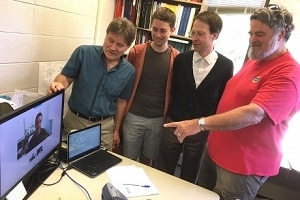Sep 23 2016
 Gordon Stacey, left, Nicholas Cothard, Thomas Nikola and George Gull speak with Steve Parshley on the video screen during an instrument team teleconference. Credit: Blaine Friedlander/Cornell Chronicle
Gordon Stacey, left, Nicholas Cothard, Thomas Nikola and George Gull speak with Steve Parshley on the video screen during an instrument team teleconference. Credit: Blaine Friedlander/Cornell Chronicle
A new, third-generation instrument will be positioned on NASA’s SOFIA to help discover the detailed building blocks of life in the cosmos. SOFIA is the airliner-based Stratospheric Observatory for Infrared Astronomy.
Professor Gordon Stacey will be heading a team of students and researchers from Cornell in order to develop the cryogenic scanning Fabry-Perot interferometers, a significant tool for identifying distant molecules.
These researchers and students will be involved in developing and building the interferometers to be part of the High Resolution Mid-InfrarEd Spectrometer (HIRMES). This new device will help to discover neutral atomic oxygen, hydrogen, water and deuterated (heavy) hydrogen molecules at infrared wavelengths ranging between 28 and 112 microns – one-millionth of a meter.
NASA highlights that the identification of these wavelengths will help to understand how oxygen, ice and water vapor merge with dust to produce plants. First light for HIRMES aboard SOFIA is scheduled for spring 2019.
These very high spectral-resolution Fabry-Perot interferometers are one of the two key technological challenges for the successful operation of HIRMES on SOFIA.
Gordon Stacey. Professor of Astronomy, Cornell University
The interferometers are devices that achieve the resolving power needed for HIRMES in order to reveal the process of gathering the raw materials that are considered to be the building blocks of life from interstellar clouds and then collapsing the raw materials into planetary systems, he stated. Another technological challenge revolves around the development of sensitive bolometers, detectors used to measure radiant energy, which is being performed by NASA’s Goddard Space Flight Center in Greenbelt, Maryland.
Members of the other Cornell team include research associate Thomas Nikola; research support specialists Steve Parshley and George Gull; visiting scientist German Cortes; and Nicholas Cothard, a graduate student in the field of applied and engineering physics. Engineering undergraduate Keith Works ’19 has started the preliminary designs for spectral filters that are to be used in HIRMES.
The team headed by Stacey will deliver three mid-resolution and high-resolution versions of the interferometers, together with two versions that are designed for imaging the surrounding galaxies. Stacey, a member of the science team for HIRMES, is also the lead scientist on the investigations involving the nearby galaxy.
SOFIA, a short-body Boeing 747SP, is globally considered to be the largest airborne observatory flying above most of the water vapor present in the Earth’s atmosphere and is also capable of making observations that seem to be impossible for even the highest and largest ground-based telescopes.
According to NASA, it was in May 1977 that Pan American World Airways originally obtained the Boeing 747 jetliner. The aircraft was named Clipper Lindbergh by Pan Am in order to honor famed aviator Charles Lindbergh, when his widow, Anne Morrow Lindbergh, named the aircraft on May 6, 1977, marking the 50th anniversary of Lindbergh’s flight from New York to Paris.
SOFIA’s instruments such as photometers, spectrometers, and cameras currently function in the far-, mid- and near-infrared wavelengths for analyzing solar system formation, star birth and death and detecting complex molecules existing in space, planets, galactic black holes, asteroids and comets in the solar system.
The HIRMES team will be headed by Samuel Harvey Moseley from NASA. Other participating institutions and agencies include Space Dynamics Lab, Precision Cryogenic Systems Inc., University of Michigan, University of Maryland, Smithsonian Astrophysical Observatory, Johns Hopkins University, Space Telescope Science Institute and the University of Rochester.